The Ultimate Guide to Integrating Direct Mail with Digital Advertising
Updated on March 28, 2023Small businesses truly need to put their businesses EVERYWHERE these days to gain the attention and awareness necessary to bring in new customers. You really can’t be a one-dimensional marketer, even on a small business scale.
The best marketers run ads on every marketing channel continuously – normally not feasible for most mom and pop shops.
I live and breathe small business, so I decided to put together this guide to help you stand out on the channels that generate the most impact and piece together the omnichannel marketing puzzle. (Omnichannel means you’re marketing your biz on every channel available.)
So here is it, your be-all, end-all ULTIMATE guide to marketing your business on every channel that matters — as easily, effectively, and efficiently as possible.
Here’s the long and short on why your business truly needs to be marketed on more than just one platform.
I completely understand why some folks would only choose one or two platforms to focus on. Just check out these stats on the effectiveness of these platforms:
- Direct mail: If you combine the response rates of email, PPC, and social media and THEN tripled that amount, it would only then be as effective as direct mail.
- Google: Every month, Google helps drive over 1 billion direct connections, like calls and online reservations, for businesses nationwide.
- Facebook: 78% of the American consumer base reported that they’ve discovered products on Facebook.
- Instagram: 200 million users will visit at least one business profile per day
- Gmail: Over 1 billion users spend, on average, 6 hours checking their Gmail messages each day.
- Youtube: 90% of ads on YouTube drive a lift in brand recall.
Now, for the research that matters the most. Bear with me, I’m going to give you a direct conclusion from the Journal of Research in Interactive Marketing from the University of Wisconsin that investigated if omnichannel marketing really works to bring in revenue. It’s filled with fancy marketing jargon, but I’ll explain how it’s relevant to you right after:
“The emergence of omnichannel marketing is breaking down the silos across available consumer-brand touchpoints. The intersection of effective omnichannel marketing and IMC strategic and tactical initiatives offers marketers an opportunity to engage their customers and to form profitable relationships.”
Okay…so what the heck does this mean? Let’s break it down. We already know that omnichannel = multichannel marketing, so…
- (Marketing) Silos = In agriculture, a silo is a structure that holds your crops. A farmer might have one silo for wheat, one for corn, one for water, etc. In marketing, a silo is a channel that holds all of your marketing for that channel. Direct mail is a silo, Facebook is another silo, so the idea is that omnichannel marketing is centralizing separate silos to work together in harmony.
- Consumer-brand touchpoints = Marketing touchpoints are any time a consumer interacts with a brand, like receiving a postcard, visiting your website or physical store, etc. In this instance, we are referring to prospects seeing and engaging with your online advertising.
- IMC strategic and tactical initiatives = IMC stands for Integrated Marketing Communications, which is a term for marketing messages that are in sync and working together to drive prospects towards a conversion. (Conversion is the term used when someone goes from prospect to customer or visitor to lead, by filling out a form.)
As a business owner, I’m sure you know what “profitable relationships” means. So in layman’s terms…
“[When done correctly] Omnichannel marketing provides businesses with more exposure than ever before and removes the need for solo efforts on every marketing channel. When these marketing channels are combined effectively, THEY MAKE YOU MONEY, both in the long and short term.”
The key here is doing omnichannel marketing CORRECTLY. If you don’t, you’re essentially burning your marketing budget to generate 0 results for your business.
That looks like this by the way:

This guide will help you incorporate the highest-producing channels into your marketing scheme so that it comes together cohesively and makes the biggest impact possible for your business — while also keeping your “work footprint” so to speak as small as possible.
That means your business will:
- make an impression on your target market,
- raise the awareness of your business with the right audience
- and ultimately guide them towards becoming your lead
- and then nurture and follow up with that lead until they buy!
Start with direct mail to ensure your targeting is laser-precise and can increase response as much as 400%
I like to use direct mail as the starting point for my marketing campaigns, from which each other marketing channel branches off. Why? Because direct mail offers a level of targeting that other platforms can’t match, and because its offline nature is more likely to draw a response, which you can more easily and affordably take advantage of through other channels.
Direct mail is a tried-and-true advertising channel to help small businesses to grow, which is also the reason I built my company around it. Even during the pandemic, we’ve managed to bring small businesses success and growth through postcards, like this dentist.
Direct mail is still around and popular today because it offers a few advantages that digital can’t come close to, especially in regards to targeting and data.
With direct mail, you can target prospects based on:
- The age of their home or how long they’ve lived there
- When their home or auto insurance policy will expire
- Whether or not they own rental property in another city or state
- If they have children in the house and how old those kids might be
- And much, much more
Digital targeting offers none of the above on a reliable basis like direct mail.
I already mentioned that direct mail outperforms all other mediums combined by more than 300%, but how does it manage to do so? WHY do our brains respond differently to physical mail than to digital ads on a screen?
A group of neuromarketers (AKA people using the science of the brain to improve marketing), when analyzing the response-driving power of direct mail, found a few answers:
- Direct mail taps into deep-seated neurological processes that trigger action.
- Direct mail marketing amplifies action by appealing to senses outside of sight and touch.
- It is better suited to closing the marketing-sales loop, or the gap between interaction and action.
But their final conclusion?
“In a connected world, brands need both interaction and action…Perhaps, then, the secret to smarter marketing lies at the cross-road of physical and digital media.”
While we know that direct mail alone works to grow small businesses, the quickest route to success is to incorporate as many weapons as possible in your arsenal.
So, start with your direct mail campaign. Work with one of my 35 highly trained marketing consultants to craft your campaign from start to finish.
Here’s an example of a postcard designed for success that incorporates all 12 of our must-have design elements:

Once you have your mailing list and your postcard design approved, sign off on mailing your postcards. Once you do this, you’ll probably have 3-5 days before your mail hits. So what’s next?
The most popular social media site in the world is an excellent place to start.
Concurrently place coordinating ads where people spend 2 hours a day scrolling — Facebook and Instagram
I know many social media channels are out there, but these two are the most successful by a landslide.
Check out the insane stats on these channels:
- 69% of adults in the United States are Facebook users.
- 1 billion people use Instagram every month.
- 52% of consumers were influenced by Facebook when making both online and offline purchases—and rising.
- 62% of Instagram users say they’ve become more interested in a product or service after seeing it in a story.
No other social media platform can boast stats like that, so, while your postcards are being processed through the United States Postal Service on their way to their final destinations, focus your marketing efforts on Facebook.
Facebook Ads are run by the Facebook Ad Manager. Instagram has its own Ad Manager but you can run it all from Facebook’s. Both use the Pay-Per-Click advertising auction model, named as such because you literally pay per click on your ad.
Facebook and Instagram ads are run and paid for through Pay Per Click bidding (also known as PPC). Your ad’s bid is determined by what you’re willing to pay for each click. The higher your bid, the more likely people are to see your ad.
This bid/auction model levels the playing field within Facebook’s ad market — which is too big to show every ad. If they did, your news feed would be nothing but ads! Nobody wants that, right? So instead, every time you log on and start scrolling, an auction takes place to determine which ads you see. Higher bids = more wins = more ad exposure. Most relevant advertising platforms use this model, including Google.
There are several major factors that go into the bidding process:
- Your bid, or how much you’re willing to pay per click.
- Your ad’s Estimated Action Rates, which is basically a score that Facebook assigns to you based on how likely someone is to click on and interact with your ad.
- Google calls this a Quality Score, which is Google’s estimation of how relevant your ad is to the consumer’s search.
- Your ad’s Quality, which is determined by many sources, mainly consumer feedback.
- Your ad’s Relevance, which is the combination of estimated action rates and ad quality — this combination determines which ads are shown to which users.
- Google calls this Ad Rank, which determines the order in which ads that made it into the auction are shown.
It’s a pretty complex system, but what you need to know is that your ads can reach your target market — as long as you define your audience correctly.
When you’re integrating campaigns, I recommend that your Facebook audience consists of the same prospects receiving your postcards.
We’ve found that using social media advertising for follow up is more effective and cost-efficient than as a lead generation tool reaching a totally cold audience.
The 2 best ways to use social media along with postcards are:
- Uploading your mailing list to the Ad Manager, which then matches records on the list to user profiles.
- Retargeting prospects that have already visited your website but did not convert in any way.
(Retargeting just means you’re showing follow-up ads to people who visited your website aka remarketing.)
We find that if you use similar imagery across all of your ads will resonate more strongly with the recipient.
Here is the follow-up Facebook Ad that coordinates with the postcard above:
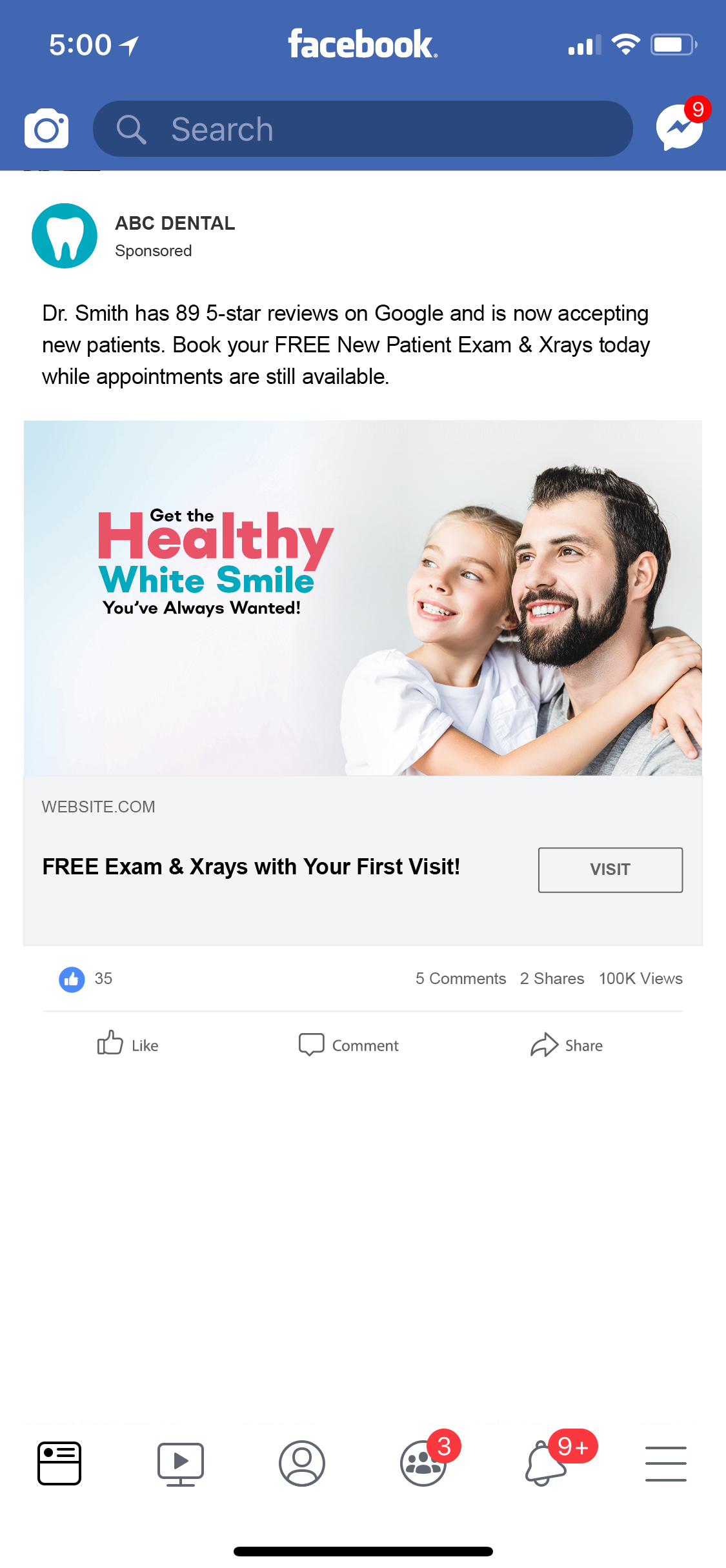
And the matching Instagram Ad:
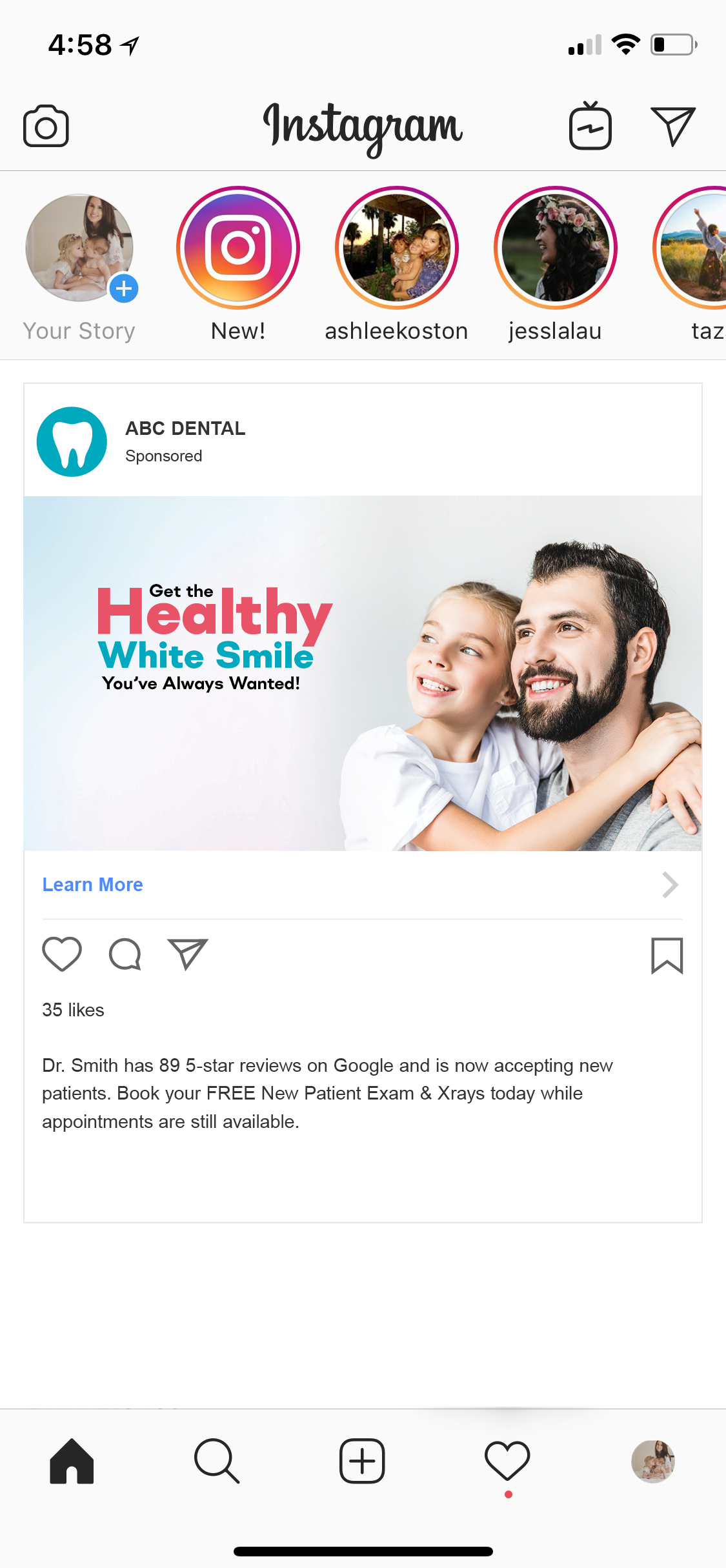
Coordinating the ads that run on each of these channels is essential to maximizing your results. If you don’t, refer back to the “shoveling your hard-earned dollars into a fire” GIF. Same deal.
The next place to focus your attention is, of course, the rest of the world wide web. Here’s how to shortcut that…
Next, set up ads on Google, a powerful follow-up tool to get your company in front of 90% of all local consumers
When you search for something in a search engine, what do you call it? Most people these days, when they don’t know something, tend to “Google” it. This is a testament to how powerful Google is.
This is especially true for small businesses. Check these stats out:
- 90% of consumers use the Internet to find a local business, will 33% searching for them daily
- 46% of all searches on Google are local
- 1 in 3 smartphone searches was made right before a store visit
While having a Google Business Profile listing is a great start, your listing can often get buried underneath your competitors. (Although we do have a few steps you can take to optimize your local SEO!)
Marketers love this adage:
“If you want to bury a body, do it on the second page of Google.”
Because nobody goes there. Just think about your own browsing behavior. When’s the last time you ever went past halfway down the page to get what you were looking for, let alone the second page? Well in all seriousness about 25% will go to the second page, but you lose out on 75% of the people.
This is where Pay-Per-Click (PPC) advertising comes in. PPC is Google’s advertising model,
If you aren’t aware, PPC ads are the first couple of results that come up when you search for something.
For example, this is our PPC ad when you Google search “Postcard Marketing”:

While there are many postcard marketing companies, ours was one of the first to come up because we utilize PPC advertising.
I realize that we’re a pretty big nationally operating company, and someone may not search for your kind of product or service like that.
A plethora of local businesses will come up with “near me” searches; check out this “dentist near me” search that I did while at home:
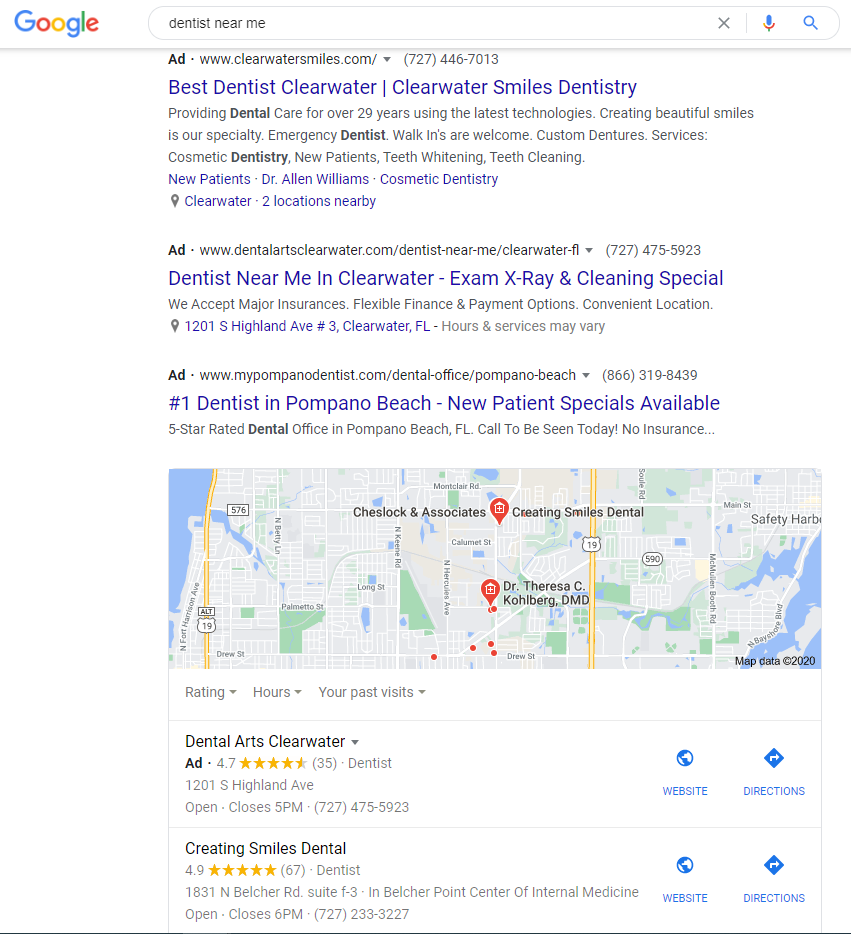
You’ll notice that the first couple of options are always going to be ads in both the Google and Google Maps results – these are the local PPC ads. Even though Creating Smiles Dental is much closer to my actual location, Dental Arts Clearwater came up first in the Google search.
Being first in the search results is a huge win. People are much more likely to visit your website — and paying for an ad can be a quick way to shortcut your way to the front of the line.
While I won’t be getting into the intricacies of how Google ads work (it’s basically the same as Facebook’s), you can read about what goes on behind the scenes here.
When it comes to your campaign, there’s an easy way to tie Google Ads in with your postcards:
Use follow-up ads!
You can easily target people who have already visited your website as a result of receiving mail pieces.
It’s a natural progression from your direct mail campaign. People get your postcard, and of those who are interested, 95% are going to visit your website. This is where Google Ads come in.
Once a prospect leaves your site without converting, they will start to see your follow-up ads all over the internet. I’m talking millions of websites, videos, and apps all across the Google Network.
The Google Network reaches 90% of the entire internet is comprised of two major sections:
- Google-owned entities like Google Finance, Gmail, Blogger, and YouTube
- Google Search Partners, who are non-affiliated sites that partner with Google to show ads. Most websites you’ve been to are likely Google partners — ESPN, Fox, CNN are just a few.
If you want to maximize this exposure, make sure these ads match your social media ads and postcard. Here are the Google Ads that my team made to coordinate with the campaign above:

The initial interest that was sparked by your postcard is then compounded by the Google, Facebook and Instagram ads.
This reminds prospects of their initial interest in your business and drives them back to your website or to call you. Ultimately, towards a conversion — giving you their email address or phone number or even purchasing.
We offer an affordable PPC Management service, or if you want to try and go it alone here’s a great beginner’s PPC guide.
But wait — you aren’t done yet! While we’re talking about Google and how to integrate its advertising platforms into your omnichannel campaign, we would be remiss to leave out the largest private email service on Earth.
Don’t forget to turn on Gmail Ads to reach people where they spend more than 5 hours a day – their inboxes
While many don’t consider Gmail one of today’s prominent digital advertising channels, in reality, it’s time to sit up and pay attention.
Gmail is another Google product that absolutely DOMINATES its respective market, boasting 1.5 billion users and 28% of the consumer email market share.
And with people spending more than five hours per day on average checking their email, this is a prime place to place some advertising.
If you’re unfamiliar, Gmail ads are placed at the top of the “Promotions” and “Social” folders within a Gmail account. Here’s a quick screenshot:

These folders were rolled out in 2013 and are intended to improve the email experience by automatically separating emails based on their content. This, in turn, creates a prime opportunity for email marketers — and for you.
Gmail ads look like this inside of those folders:

Since I’m a marketer and SEMrush makes marketing software, I’m constantly targeted by them.
When you click into the ad, it expands to look like this:
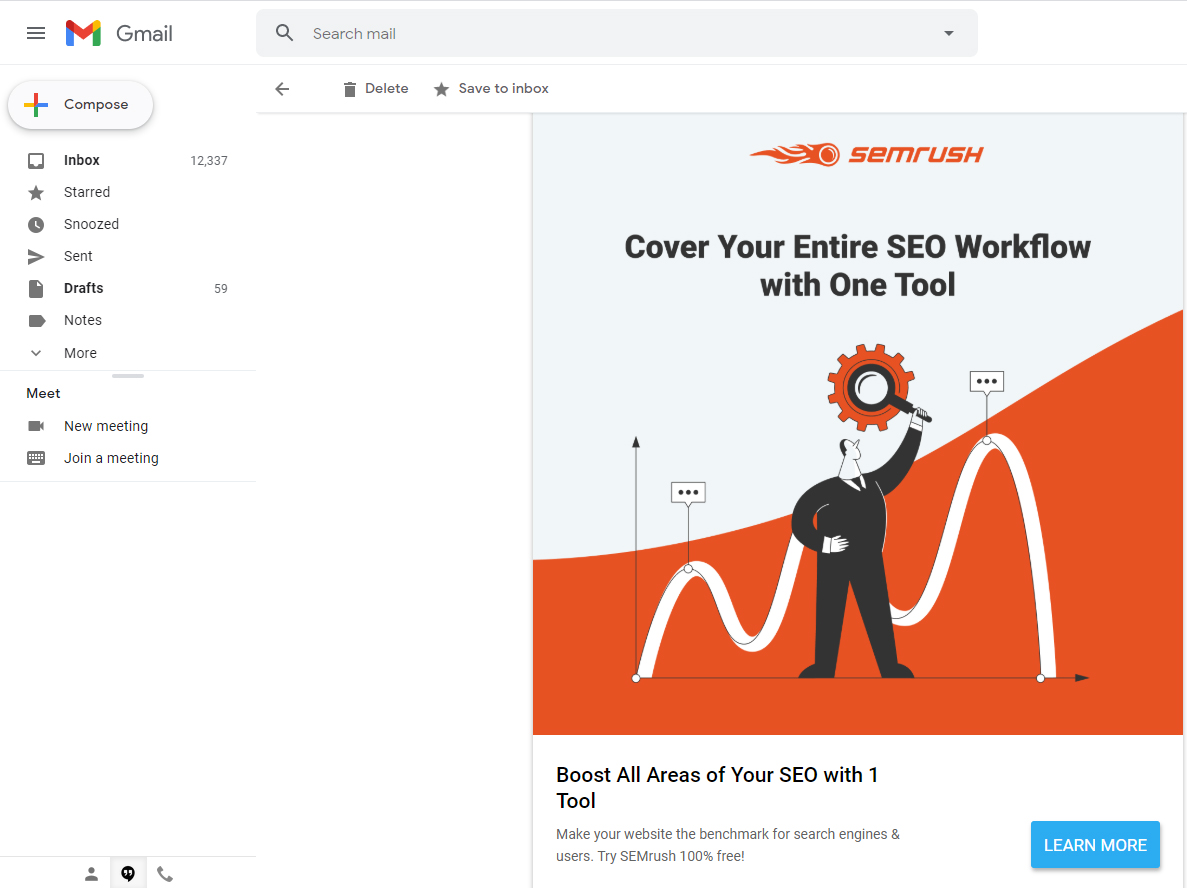
It’s important to make the distinction between the “Spam” and “Promotions” folders. While spam mail is ineffective and annoying (and driven straight to a Spam folder that is largely hidden from view within Gmail), consumers LOVE having deals at their fingertips.
Check this out:
47% of people check the Gmail Promotions folder daily. Basically half!
That means millions of people are looking for a good offer daily, and your business could be right there.
Here’s a good example of a Gmail ad designed to coordinate with the dental campaign above:
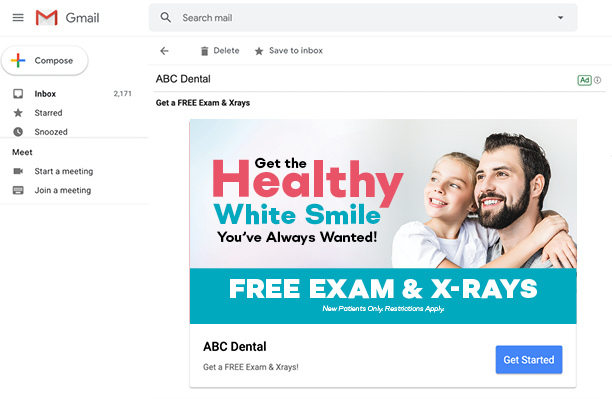
So now, if you’re keeping track (and you should be), people will come across your campaign…
- At home, when they’re going through their mail
- On Facebook, while they’re browsing their feed
- Online, while they’re surfing the web
- In their inboxes, while they’re checking their email
There’s just ONE more piece to this puzzle — don’t quit on me yet.
Because once you add America’s favorite video hosting platform to your marketing mix, your message will truly appear EVERYWHERE your consumers go.
Add YouTube ads to achieve true omnichannel presence and reach 51% of daily users that spend hours every week watching videos
Last but not least, where most of the world get their video content:
YouTube.
Attracting over 2 billion users a day to its site to watch one billion hours of videos, YouTube has a formidable audience. In fact, 51% of YouTube users claim they visit the site daily. That puts YouTube right up there among the ranks of Facebook and Instagram if you ask me.
By adding this last piece of the marketing scheme puzzle, your business will literally be EVERYWHERE your prospects spend time both online and offline.
YouTube ads come in 6 different forms. I’m going to break all 6 down for you.
Display ads appear to the right of the featured video and above the suggested list.
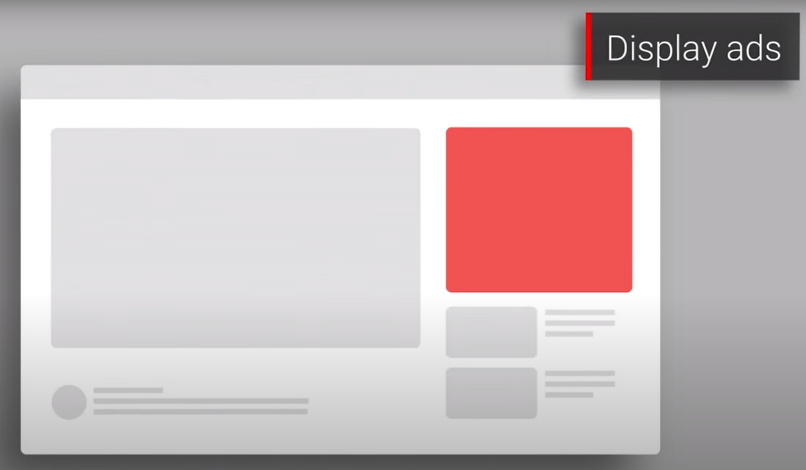
Overlay ads appear at the bottom of the featured video.
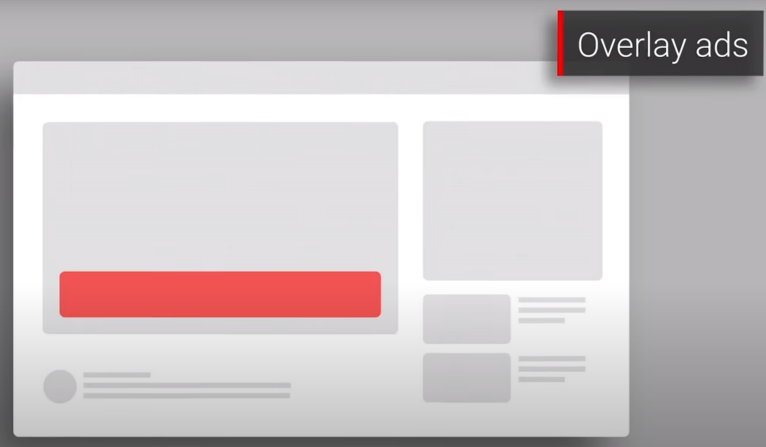
Bumper ads are non-skippable ads that must be watched before you can view the featured video.
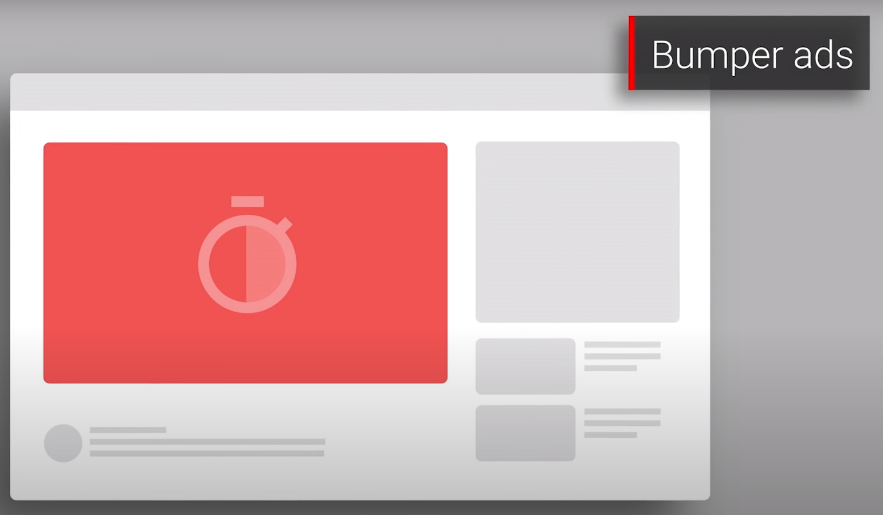
Skippable and non-skippable ads are also played before featured videos.

Sponsored Cards display advertising relevant to the content of the featured video.
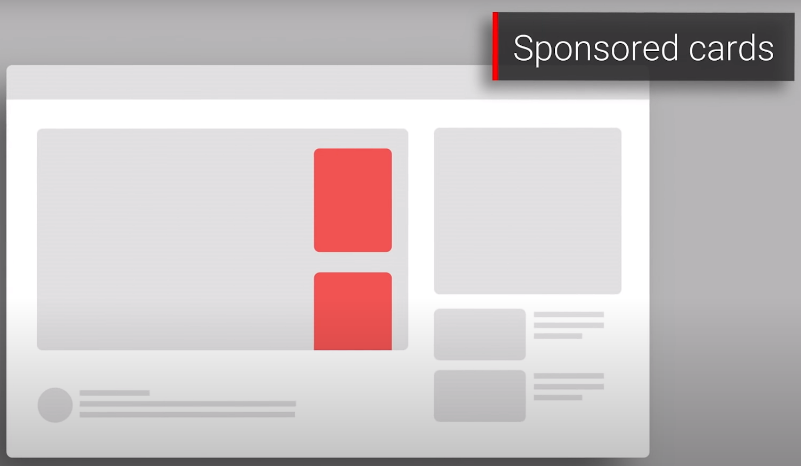
And lastly, we have Mid-Roll Ads, which are ads placed within long featured videos that must be watched to continue.

The type of ad you run on YouTube is completely up to you and what you have available. Obviously, if you don’t have a video, you can’t run a playable ad. But you still have options to get your message out there — so don’t write off YouTube just because you don’t have a super slick video at hand.
Here’s a matching YouTube Skippable Ad from the dental campaign I’ve been showing you:
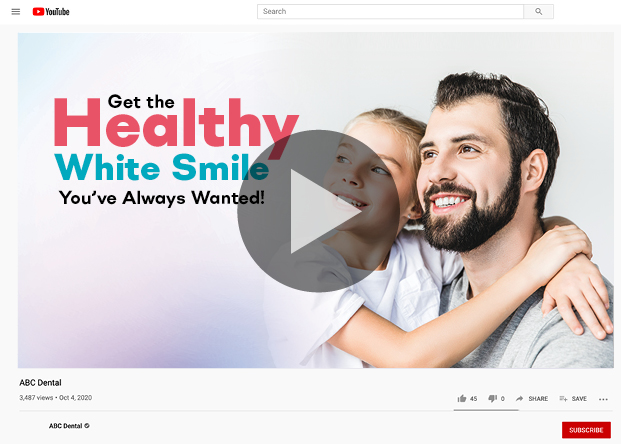
YouTube Ads also use the PPC model I described earlier, with some minor differences.
Ever go down a YouTube video wormhole, and soon find yourself several hours deep into related videos? Everyone does, and YouTube is unique in the way they use this to target audiences.
They offer:
- Topic-based Targeting: You bid to have your ads shown alongside videos on certain channels dedicated to a certain topic (cooking, fitness, really anything).
- Placement-based Targeting: You pick specific YouTube channels that you think your target audience will be watching.
Of course, there’s a lot more to YouTube ads and bidding, but I don’t want to get too into the weeds.
I want to get to the most important part…
To sum it up: You MUST combine direct mail and digital marketing because modern consumers require it — and also because it increases your ROI 60%.
What’s most important is having a coherent, coordinated message from your business across multiple platforms — basically, every place the modern consumer spends their time.
- At home (with postcards)
- On Facebook or Instagram
- Online, surfing the web (via Google)
- Checking their personal emails (that’s Gmail)
- And watching videos on YouTube
Here’s how that can look in practice, all put together:





The impact is HUGE.
As a consumer, you’re definitely going to notice a campaign like this.
As a business, that means you’re making someone aware of you — and that gives you a huge edge on the competition. People like the comfort and security of familiarity, and they like the assurance of a legitimate business that is able to coordinate a campaign like this one.
Without a doubt, the most critical piece of the marketing scheme puzzle is to synchronize and track each platform to make sure they work together and make adjustments based on their performance.
Each platform is tracked differently. Direct mail, Google, Gmail, Facebook, Instagram, and YouTube all have different metrics that mean different things.
If it seems like a lot, it’s because it is, especially if you don’t have a background in marketing.
It is genuinely dizzying to keep track of all of these metrics simultaneously, especially for a small business owner without a dedicated marketing person.
We actually built a custom dashboard to feed all of these different metrics from different platforms into one simple, streamlined place for you. I’ve heard from small business owners that it’s one of the biggest perks of this product because it’s a massive time-saver and simplification of an otherwise tedious process.
Here’s a screenshot of that dashboard, with the campaign tracking highlighted:
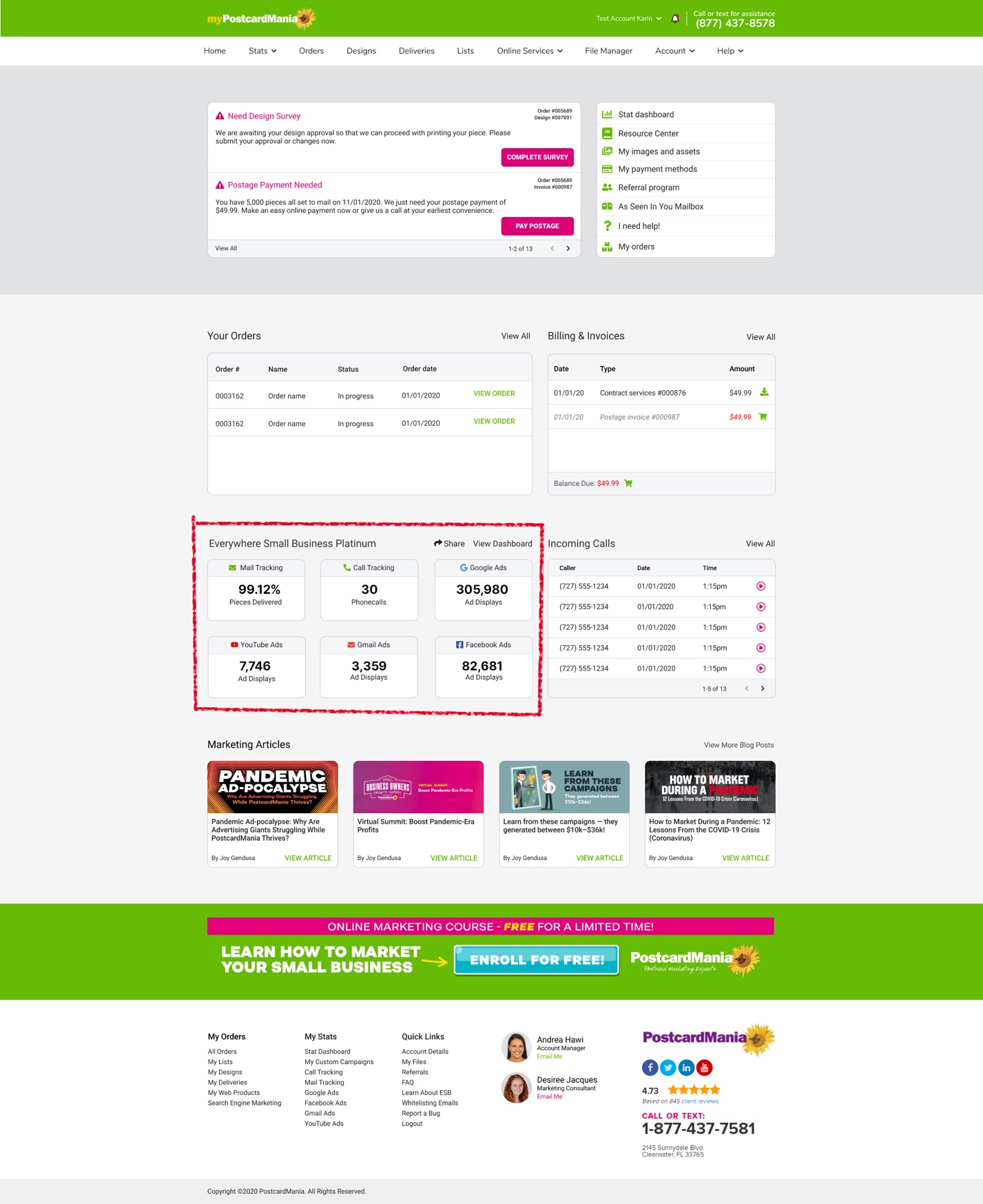
Typically, for a business to outsource their marketing for a campaign with all of these channels, it would require a massive retainer with an ad agency. And for most small businesses, that kind of budget isn’t feasible.
That is, until my Everywhere Small Business product hit the market, which was the first of its kind and generated a lot of buzz. It made even more buzz when the product outperformed projections by 234% and caused a hiring spark at PostcardMania.
Everywhere Small Business combines the power of direct mail with Google, Facebook, and Instagram ads and provided tracking methods for each.
Now, I bring you the next buzzworthy update in the Everywhere Small Business saga –Everywhere Small Business Platinum!
The platinum edition combines everything I mentioned above:
- Targeted postcard marketing
- Facebook and Instagram ads
- Google ads
- YouTube ads
- Gmail ads
- Call tracking
- A single, centralized performance dashboard
In one user-friendly and affordable package, this service utilizes all of the most effective marketing channels mentioned above — managed by highly trained professionals for you — at a fraction of the price a fancy ad agency would charge you.
We just rolled it out recently.
Check it out here! You can also request a free demo to see exactly how it would work with your business.
If you need any other marketing help with your business, we offer one-on-one consultations for FREE with trained marketing experts. Just call 1-800-628-1804, and again:
It’s FREE.
As always, we are open and ready to help you!
Best,
Joy
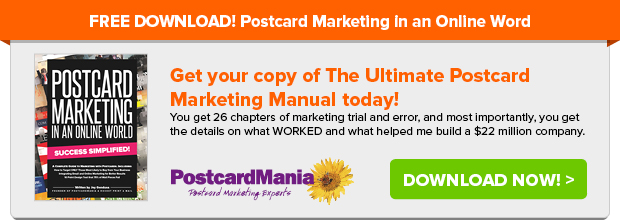
4 Comments
I’m so glad you found it helpful! Thanks for reading!!
This is a really, really great one! Thank you.
Thanks for reading, Nikki!

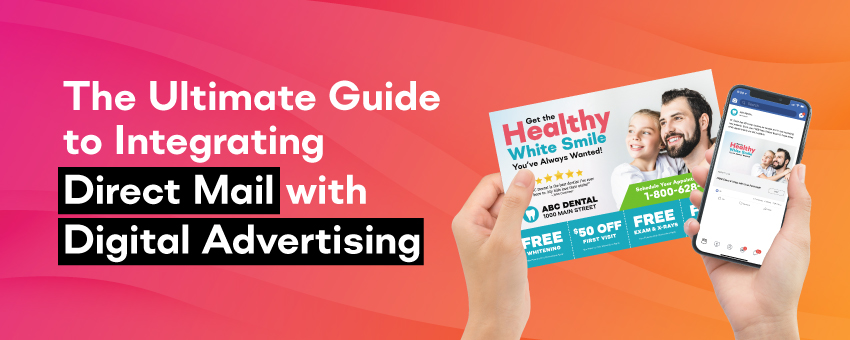



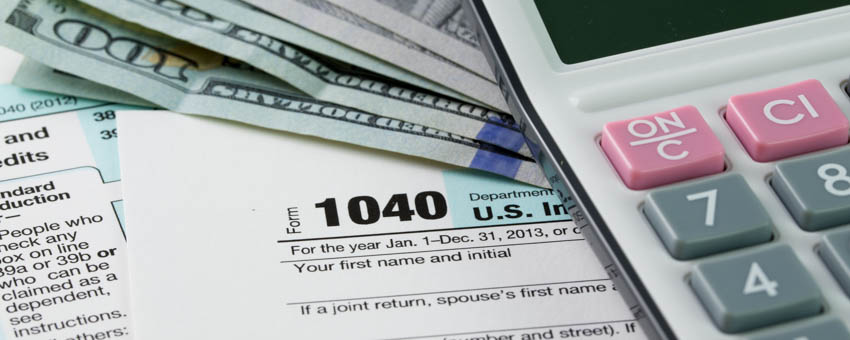
Nice article! You’ve made some sophisticated marketing concepts very clear and simple to understand!